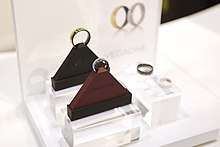Smart ring
A smart ring is a wearable electronics device with advanced mobile components that combine features of mobile devices with innovative features useful for mobile or handheld use. Smart rings, which are typically the size of traditional rings or larger, combine the features of a mobile device, such as the ability to make payments and mitigate access control, with popular innovative uses such as gesture control and activity tracking. Smart rings can communicate directly with smart phones or personal computers through a variety of applications and websites, and operate without the need to carry a smart phone, such as when interacting with back-end systems on the cloud through or performing standalone functions such as activity tracking. They typically do not have a display and operate by contextual relevance, such as by making a payment when near a payment terminal, unlocking an electronic lock when near the lock, or controlling home appliances when making gestures in the home. Some smart rings have physical or capacitive buttons to use as an activation mechanism, such as to initiate a gesture.
In 2013, the English firm McLear released the first smart ring for sale. The market is currently around $25 million.
Use
The main feature of the smart ring is to serve as a near-field communication device, effectively eliminating the need to carry credit cards, door keys, car keys, and potentially even ID cards or driver's licenses.[1][2] Other features include connection to a smartphone in order to notify the user of incoming calls, text, emails, and more; use as gesture-based controller, allowing the user to perform a variety of actions with a simple motion of the hand; and measure steps, distance, sleep, heart rate, and track how many calories the user consumes.[3][4]
Security
Secure access control such as for company entry and exit, home access, cars, and electronic devices was the first use of smart rings. Smart rings change the status quo for secure access control by increasing ease of use, decreasing physical security flaws such as by ease of losing the device, and by adding two-factor authentication mechanisms including biometrics and key code entry.
Payments and ticketing
Smart rings can perform payments and metro ticketing similar to contactless cards, smart cards, and mobile phones. Security of the transaction is equal to or greater than contactless cards. The first smart ring to be created with contactless payments was the NFC Payment Ring, which was mass produced and unveiled at the Olympics Summer Games at Rio de Janeiro in August 2016.

Activity
Replicating smartwatches, smart rings provide features including activity tracking (i.e. step tracking), heart beat tracking, and sleep tracking (through measuring heart beats and movements). The smart ring form factor contains enough space to contain the same components as smart watches. Due to size constraints, smaller components are typically used in current smart ring products in market, such as smaller and less accurate accelerometers, and smaller batteries leading to lower battery life than smart watches.
Social
Smart rings provide social feedback to users and can be used to engage in the user's environment in a way that other wearables and mobile devices do not permit. Ringly produces a women's fashion smart ring which lights to notify the user when the user receives a text message, phone call, or other notification. This enables the user to be aware of the notification without having to constantly check her or his smart phone.
See also
References
- ↑ M., Joe (August 24, 2016). "The long-awaited NFC Ring will finally land on your finger this December". Phone Arena. Retrieved November 21, 2016.
- ↑ Boden, Rian (August 24, 2016). "NFC Ring circles the globe". NFC World. Retrieved November 21, 2016.
- ↑ Widder, Brandon (February 23, 2015). "Put a ring on it: 4 smart rings that are more useful than getting you engaged". Digital Trends. Retrieved November 21, 2016.
- ↑ Plummer, Libby (July 7, 2016). "Smart rings: The good, the bad and the ugly in smart jewellery". Wearable.com. Retrieved November 21, 2016.